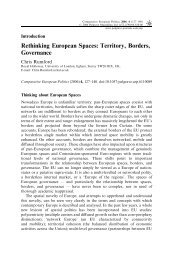Europeanisation, National Identities and Migration ... - europeanization
Europeanisation, National Identities and Migration ... - europeanization
Europeanisation, National Identities and Migration ... - europeanization
You also want an ePaper? Increase the reach of your titles
YUMPU automatically turns print PDFs into web optimized ePapers that Google loves.
130 Willfried Spohn<br />
about 6 million Poles, 3 million ethnic Poles <strong>and</strong> 3 million Polish Jews, lost their lives.<br />
The death toll disproportionately affected the Polish elites, because Nazi Germany<br />
<strong>and</strong> the Soviet Union especially aimed to erase the leadership of the Polish nation.<br />
After the war almost 2 million Poles were expelled from the Eastern territories<br />
<strong>and</strong> resettled in the Western Polish former Eastern German regions. According<br />
to German <strong>and</strong> Polish numbers (which still conflict), of the 10 million former<br />
German inhabitants of these regions about 7 million fled or were expelled, of whom<br />
about one half were refugees escaping the Red Army <strong>and</strong> the other half expelled<br />
by the Polish administration; 2 million were killed, about 1.6 million of whom during<br />
expulsion; <strong>and</strong> about 1 million (though then diminishing) stayed as ‘autochthonous’<br />
citizens within post-war Pol<strong>and</strong>. 9<br />
These enormous territorial <strong>and</strong> demographic changes had two major interrelated<br />
structural implications for the post-war reconstruction of both nations. The first<br />
implication was that two nations historically overlapping in their ethnic settlement<br />
structures <strong>and</strong> conflictively entangled in the process of nation-building became<br />
finally separated. Though this national disentanglement included enormous<br />
suffering <strong>and</strong> caused lasting traumas on both sides, this separation also opened the<br />
long-term possibility to reconstruct both nations <strong>and</strong> the relations between them<br />
in new ways. 10 At the same time, the emerging bloc confrontation between the<br />
victorious allies over defeated Nazi Germany defined specific international<br />
conditions under which the reconstructions of both nations <strong>and</strong> their mutual<br />
relations took place. The two nations did not develop in the form of two independent<br />
states, but under the respective hegemony of the Western <strong>and</strong> Eastern bloc.<br />
Germany deprived of its independent nationhood became divided in two parts,<br />
West Germany in close international integration with <strong>and</strong> under more indirect<br />
supervision by the Western allies, <strong>and</strong> East Germany under direct military control<br />
by the Soviet Union. Pol<strong>and</strong>, despite its belonging to the victorious alliance, also<br />
lost its independent nationhood, became subjected to the Soviet Union <strong>and</strong> forced<br />
to be a partner of East Germany in the Soviet interstate system. Under these<br />
international conditions, West Germany, defining itself as the legal successor state<br />
of the Third Reich <strong>and</strong> the major recipient of the Eastern refugees <strong>and</strong> expellees,<br />
did not officially recognise <strong>and</strong> only gradually accepted the loss of its Eastern<br />
territories. By contrast, East Germany was forced by the Soviet Union to recognise<br />
the Odra–Neisse border but was reluctant to accept it. Pol<strong>and</strong>, in recompense for<br />
the enormous losses, took possession of the former Eastern German regions, but at<br />
the same time remained basically insecure in its national territory as long as West<br />
Germany did not recognise its international legality. This national insecurity made<br />
Pol<strong>and</strong> inversely dependent on the ‘protection’ by the Soviet Union.<br />
The second implication of these territorial <strong>and</strong> demographic changes was that<br />
each nation became basically congruent with the emerging political state structures.<br />
In the case of Germany, the loss of the Eastern territories as well as the flight<br />
<strong>and</strong> expulsion of the German populations from their Eastern German <strong>and</strong> Eastern<br />
European homel<strong>and</strong>s, implied a decisive break with its former pattern of nationbuilding.<br />
For the first time in German history, the settlement structure of the<br />
German-speaking population found itself in a basic congruence with territorial <strong>and</strong>



